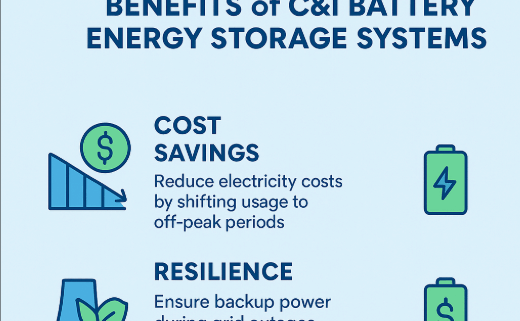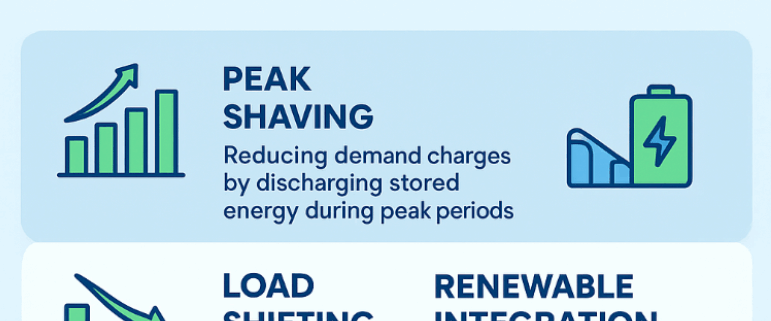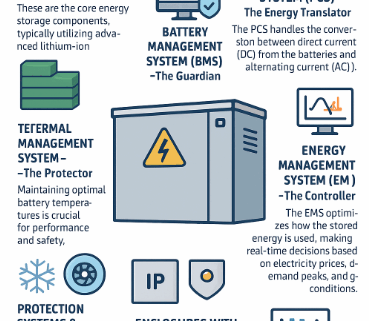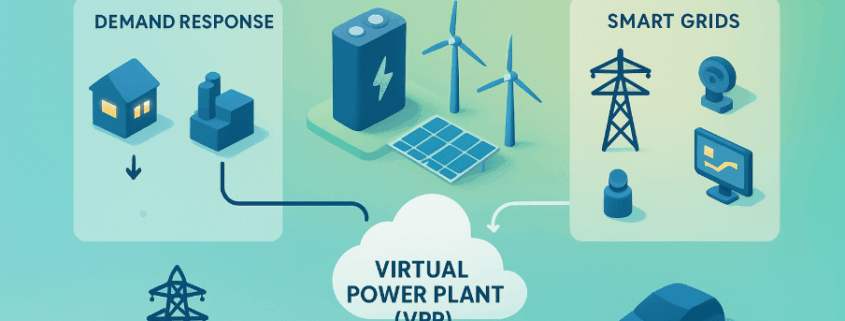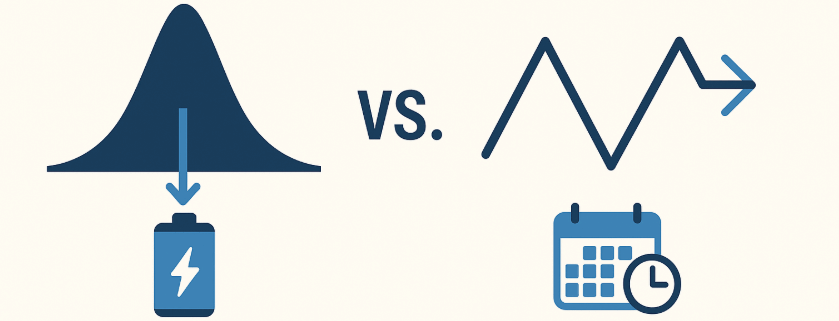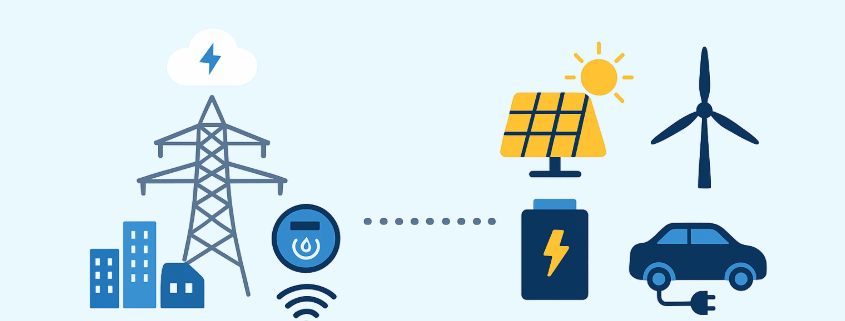Key Benefits of C&I Battery Energy Storage Systems (C&I BESS) for Enterprises
C&I BESS Benefits: The adoption of Commercial & Industrial Battery Energy Storage Systems (C&I BESS) is accelerating as businesses seek smarter energy solutions. While the technology itself is impressive, the real value lies in the benefits it brings to organizations.
From lowering energy bills to improving power resilience and supporting sustainability goals, a C&I BESS is more than just a storage system—it’s a business enabler. Let’s explore the key benefits that make C&I BESS essential for modern enterprises.
1. C&I BESS Benefits: Significant Cost Savings
One of the biggest benefits of C&I BESS is reducing energy costs. With applications such as peak shaving and load shifting, businesses can:
- Avoid high demand charges
- Buy energy at off-peak rates
- Optimize usage during expensive periods

These savings can quickly add up, delivering a strong return on investment for businesses of all sizes.
2. C&I BESS Benefits: Energy Resilience and Reliability
For industries where downtime is not an option, a C&I BESS provides uninterrupted power supply during outages. Unlike traditional generators, BESS systems deliver instant backup without noise or emissions.
This benefit is particularly critical for:
- Manufacturing plants
- Data centers
- Healthcare facilities
- Logistics hubs

With a C&I BESS, businesses gain confidence in maintaining smooth operations even when the grid is unstable.
3. C&I BESS Benefits: Sustainability and Carbon Reduction
C&I BESS is a key driver of sustainability. By storing energy from renewable sources like solar or wind, businesses reduce reliance on fossil fuels and cut carbon emissions.

This not only improves environmental impact but also strengthens corporate ESG (Environmental, Social, and Governance) performance, which is increasingly important to investors and customers.
4. Revenue Opportunities
Beyond savings, a C&I BESS can generate new revenue streams. Through demand response programs, businesses can supply energy back to the grid during peak times and earn incentives from utilities.

This transforms the C&I BESS into an active energy asset that contributes to financial growth.
5. Scalability and Flexibility
A major benefit of C&I BESS is its scalability. Systems can be tailored to fit specific needs, whether for small commercial operations or large-scale industrial facilities.
As energy demands grow, additional capacity can be added, ensuring businesses always have a solution that adapts to their needs.
6. C&I BESS Benefits: Support for EV Charging Infrastructure
With the rise of electric vehicles, businesses are increasingly installing charging stations. A C&I BESS helps manage charging loads by reducing strain on the grid and lowering infrastructure costs.
This benefit makes C&I BESS especially valuable for fleet operators, transport companies, and commercial charging hubs.
7. Enhanced Grid Participation
C&I BESS benefits extend beyond the facility itself. By supporting grid stability functions such as frequency regulation and voltage control, businesses contribute to a stronger, more reliable energy network.
This not only benefits utilities but also enhances the reputation of the business as a proactive energy leader.
Conclusion
The benefits of a C&I BESS go far beyond storage. From cost savings and resilience to sustainability, scalability, and new revenue opportunities, these systems offer long-term value to businesses across industries.

As energy demands grow and sustainability targets tighten, investing in a C&I BESS is not just a strategic decision—it’s a competitive advantage.
👉 Curious about real-world uses? Explore the Top Applications of C&I BESS to see how businesses are already leveraging these benefits.
Top Applications of Commercial & Industrial Battery Energy Storage Systems (C&I BESS)
Top applications of C&I BESS: As energy costs rise and power reliability becomes a growing concern, businesses are turning to Commercial & Industrial Battery Energy Storage Systems (C&I BESS). These systems go beyond storing electricity — they provide flexible solutions that help companies cut costs, enhance resilience, and meet sustainability goals.
Here, we explore the top applications of C&I BESS that are transforming the way businesses manage energy.
1. Peak Shaving – Reducing Demand Charges
One of the most common applications of C&I BESS is peak shaving. Utilities often charge businesses based on their highest electricity demand during peak periods. By discharging stored energy at these times, a C&I BESS reduces demand charges significantly.

This translates to major cost savings, especially for manufacturing plants, data centers, and large commercial facilities with fluctuating power needs.
2. Load Shifting – Smarter Energy Use
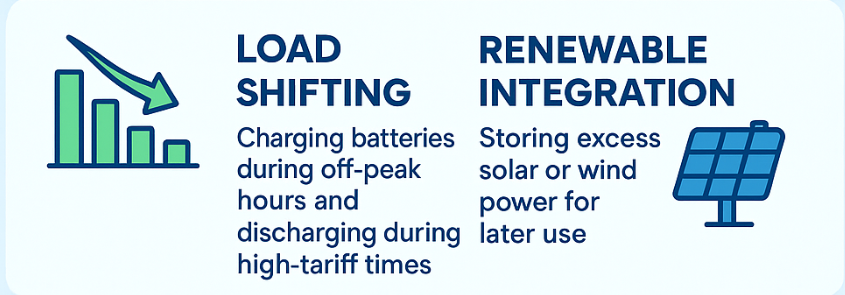
A C&I BESS enables smarter energy usage, ensuring businesses maximize cost efficiency while maintaining reliable operations.
3. Renewable Energy Integration – Unlocking Sustainability
C&I BESS plays a crucial role in making renewable energy sources like solar and wind more reliable. Since renewables are intermittent, storage ensures that excess generation can be stored and used later.
This makes it easier for businesses to rely on clean energy, reduce dependence on the grid, and achieve sustainability targets.
4. Backup Power & Resilience – Business Continuity
Power outages can disrupt operations, damage equipment, and cause financial losses. A C&I BESS provides backup power, ensuring continuity during grid failures.
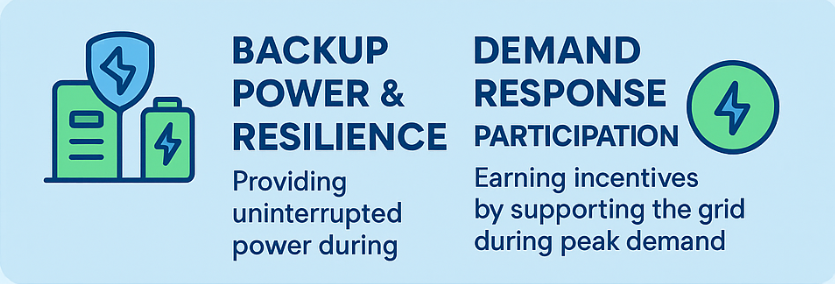
Unlike traditional diesel generators, BESS offers silent, clean, and instant backup, making it a better long-term solution for critical facilities such as hospitals, factories, and logistics hubs.
5. Demand Response Participation – New Revenue Streams
With demand response programs, businesses can use a C&I BESS to support the grid during peak times. By discharging energy when the grid is strained, companies not only contribute to stability but also earn incentives from utilities.
This turns a C&I BESS into a revenue-generating asset, not just a cost-saving one.
6. Electric Vehicle (EV) Charging Support – Fast & Efficient
As EV adoption grows, many businesses are installing charging infrastructure. However, fast charging requires significant power, which can strain the grid.

A C&I BESS helps smooth EV charging loads, reducing peak demand and ensuring consistent charging availability. This makes it ideal for fleet operators, logistics companies, and commercial charging stations.
7. Microgrid & Grid Support – Local Energy Independence
In regions where the grid is unstable, a C&I BESS enables microgrids — self-sufficient energy systems that can operate independently.
By integrating renewables, storage, and local generation, businesses gain energy independence while also supporting grid functions like voltage regulation and frequency balancing.
Conclusion
The applications of C&I BESS extend far beyond energy storage. From peak shaving and load shifting to renewable integration, backup power, EV charging support, and microgrid participation, these systems deliver unmatched flexibility and value.
For businesses seeking to cut costs, increase reliability, and move toward sustainability, a C&I BESS is no longer optional — it’s essential.
👉 Want to understand how these applications connect to the system itself? Read our detailed guide on the Key Components of a C&I BESS.
Key Components of a Commercial & Industrial (C&I) Battery Energy Storage System (BESS)
As businesses look for smarter energy solutions, Commercial & Industrial Battery Energy Storage Systems (C&I BESS) are leading the transformation. These systems help companies cut electricity costs, improve power reliability, and integrate renewable energy sources.
A Commercial & Industrial BESS is more than just a battery—it is a complex system built with advanced components that ensure performance, safety, and resilience. Let’s explore the key components of a C&I BESS, including the protective enclosures and fire safety systems that make them robust for industrial use.
1. Battery Modules – The Energy Core
The battery modules are the foundation of every C&I BESS. They store excess electricity from renewable energy sources such as solar or from the grid during off-peak hours.
Most C&I BESS installations use lithium-ion technology, particularly Lithium Iron Phosphate (LFP), because it delivers high efficiency, fast response times, and longer cycle life. These modules provide reliable storage while meeting the high demands of industrial operations.
2. Battery Management System (BMS) – The Guardian
Within a C&I BESS, the Battery Management System (BMS) ensures the safe and efficient operation of every cell. It monitors:
- Voltage and current
- State of charge (SOC) and state of health (SOH)
- Temperature variations across modules
By preventing overcharging, deep discharging, and overheating, the BMS extends battery life and safeguards the entire C&I BESS against failures.
3. Power Conversion System (PCS) – The Energy Translator
- Inverter: DC to AC during discharge
- Rectifier: AC to DC during charging
With bidirectional flow, the PCS allows the C&I BESS to provide services like peak shaving, load shifting, and grid support, ensuring seamless energy transitions.
4. Energy Management System (EMS) – The Controller
The Energy Management System (EMS) is the control center of a C&I BESS. It manages when to store or release energy based on demand, pricing, and renewable generation.
Key EMS functions in a C&I BESS include:
- Peak shaving to reduce costly demand charges
- Load shifting for off-peak savings
- Renewable integration for solar and wind energy
- Grid support through voltage and frequency stabilization
The EMS ensures that the C&I BESS not only stores power but also strategically enhances efficiency and sustainability.
5. Thermal Management System – The Protector
For safe and efficient operation, a C&I BESS requires precise temperature control. The thermal management system maintains battery modules within safe operating ranges using:
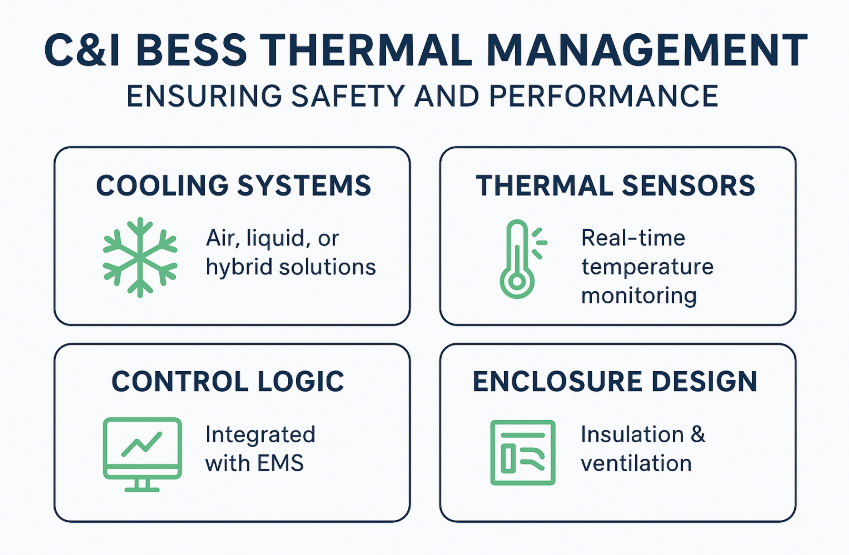
- Forced air cooling
- Advanced liquid cooling systems
- Phase change materials (PCM) for high-performance applications
These solutions prevent overheating, extend battery life, and ensure the C&I BESS can perform reliably under demanding industrial conditions.
6. Protection Systems & Circuit Breakers – The Safety Net
Every C&I BESS must withstand electrical challenges. Protection systems include:
- Circuit breakers to isolate faults
- Surge protectors to handle voltage spikes
- Overcurrent protection for high-load safety
These safeguards ensure the C&I BESS remains reliable, even in complex grid or facility environments.
7. Enclosures with IP Ratings – The Shield
The enclosures of a Commercial & Industrial BESS are not just protective shells—they are engineered shields that keep the system safe from environmental threats.
Most enclosures meet IP54 to IP66 ratings, ensuring resistance to dust, water, and extreme conditions. For example:
- IP54/IP55: Protection from dust and water spray (suitable for indoor or mild outdoor environments)
- IP65/IP66: Fully dust-tight and resistant to strong water jets (ideal for harsh outdoor conditions)
With corrosion resistance, robust construction, and climate protection, IP-rated enclosures enable C&I BESS systems to deliver reliable performance in diverse locations.
8. Fire Safety Systems – The Last Line of Defense
Safety is a defining factor of any Commercial & Industrial BESS design. To prevent hazards such as thermal runaway, modern systems include:
- Early smoke and gas detection
- Automatic fire suppression systems (clean agent, inert gas, or aerosol-based)
- Fire barriers and controlled venting to contain emergencies
These features align with UL 9540A fire testing and IEC standards, making C&I BESS installations safe and compliant with global regulations.
9. Monitoring & Communication Systems – The Connectors
Advanced monitoring and communication systems give operators real-time visibility into the performance of a C&I BESS.
With IoT-enabled dashboards, operators can:
- Track state of charge and performance trends
- Perform predictive maintenance
- Integrate the Commercial & Industrial BESS with building energy management systems (BEMS) and utility controls
This connectivity ensures the C&I BESS remains intelligent, efficient, and adaptive to evolving energy needs.
Conclusion
A Commercial & Industrial BESS is a highly engineered energy solution that combines battery modules, BMS, PCS, EMS, thermal management, protection systems, IP-rated enclosures, fire safety, and communication platforms.
Every component in a C&I BESS plays a vital role in delivering efficiency, safety, and reliability. By investing in well-designed systems, businesses can unlock cost savings, improve resilience, and contribute to a sustainable energy future
Demand Response in Virtual Power Plants: Balancing Energy Supply and Demand
In today’s energy landscape, flexibility is just as important as generation. As renewable energy adoption grows, balancing supply and demand has become a major challenge. Demand Response (DR), when integrated into Virtual Power Plants (VPPs), offers a powerful solution to achieve this balance. By intelligently shifting or reducing electricity usage during peak hours, demand response ensures a more resilient, affordable, and sustainable energy system.
What Is Demand Response?
Demand Response is an energy management strategy where consumers adjust their electricity usage in response to grid conditions, price signals, or incentives. Instead of relying solely on power plants to ramp up supply, DR helps reduce stress on the grid by adjusting demand.
When this capability is connected to a Virtual Power Plant, thousands of distributed assets — from smart appliances to EV chargers — can collectively act as a flexible energy resource.
How Demand Response Works in Virtual Power Plants
- Real-Time Monitoring: Smart meters and IoT devices track consumption patterns.
- Automated Control: Appliances, batteries, and HVAC systems adjust based on grid signals.
- Aggregated Flexibility: Small changes across households and businesses add up to major load reductions.
- Bidirectional Benefits: Consumers earn incentives, while grid operators reduce stress on infrastructure.
Benefits of Demand Response in VPPs
- Grid Stability – Reduces blackouts and stabilizes renewable variability.
- Cost Savings – Consumers and businesses lower bills by shifting use to off-peak hours.
- Decarbonization – Maximizes the integration of renewable energy by reducing reliance on fossil-fuel backup plants.
- Resilience – Communities gain more reliable access to electricity during extreme demand peaks.
Real-World Applications
- United States: California’s Flex Alert program rewards consumers for reducing usage during peak times, and when tied into VPPs, it supports grid resilience during heatwaves.
- Europe: Germany and the UK are experimenting with large-scale DR programs integrated into VPP platforms to balance wind and solar fluctuations.
- Asia: Japan’s utilities use DR to manage peak demand from air conditioning loads in summer while leveraging VPP networks.
Demand Response + Smart Grids + Storage
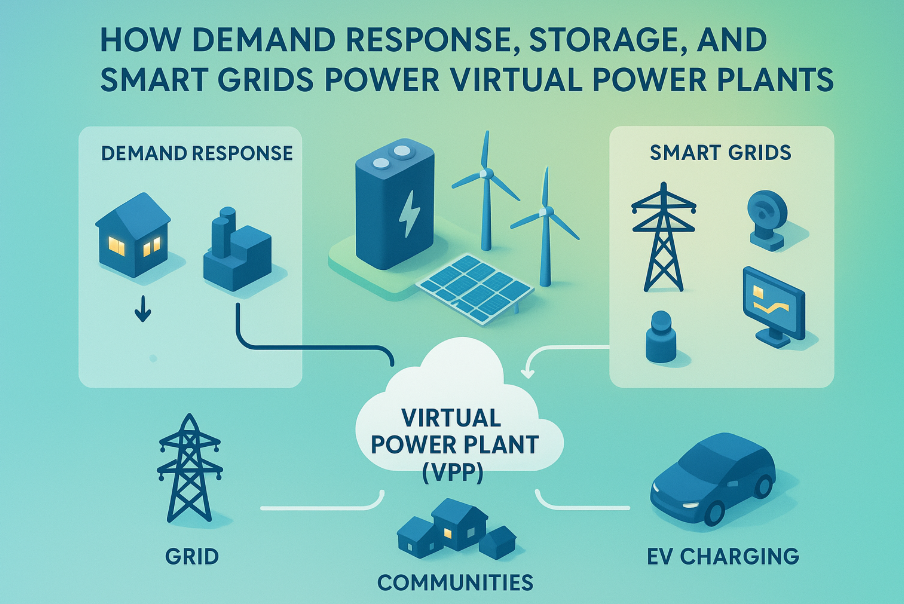
Demand Response becomes even more effective when combined with:
- Smart Grids, which provide the intelligence to coordinate energy flows.
- Battery Storage, which captures excess energy and releases it during peak demand.
- Renewables, ensuring cleaner, more sustainable demand-shifting solutions.
Conclusion
Demand Response is the hidden power of Virtual Power Plants. By engaging consumers and leveraging automation, it transforms passive energy users into active participants in grid management. The result is a system that is smarter, cleaner, and more resilient for everyone.
Peak Shaving vs Load Shifting: Understanding the Difference in Energy Management
Peak Shaving vs Load Shifting: Businesses and industries face growing pressure to optimize energy use while reducing costs. Two strategies frequently discussed in energy management are peak shaving and load shifting. Although they are often mentioned together, they serve different purposes. Understanding these differences helps organizations select the right approach to lower bills and improve grid stability.
What Is Peak Shaving?
Peak shaving is the process of reducing energy consumption during times of peak demand. These are periods when electricity prices are highest and the grid is under maximum stress. Companies achieve peak shaving through:
- Using on-site backup generators
- Deploying battery energy storage systems (BESS)
- Adjusting or reducing non-essential loads
By trimming energy use during critical hours, businesses can avoid hefty demand charges. For example, a manufacturing plant may rely on stored battery power during late afternoons when energy tariffs spike.
What Is Load Shifting?
Load shifting, on the other hand, involves moving energy consumption from high-demand periods to times of lower demand. Rather than reducing total energy use, companies simply reschedule when they consume it.
Practical examples include:
- Running industrial chillers at night when electricity is cheaper
- Charging electric vehicles during off-peak hours
- Pre-cooling commercial buildings before daytime demand increases
Load shifting helps flatten demand curves, which supports grid reliability and can reduce overall operating expenses.
Key Differences: Peak Shaving vs Load Shifting
While both strategies improve efficiency, their focus differs:
| Aspect | Peak Shaving | Load Shifting |
|---|---|---|
| Objective | Reduce usage during peak hours | Move usage to off-peak hours |
| Method | Curtail demand or use stored energy | Reschedule operations |
| Impact | Lowers demand charges | Optimizes energy costs |
| Example | Using BESS at 6 PM peak | Running equipment at midnight |
Benefits of Peak Shaving
- Lower demand charges: Reduces utility costs during peak hours
- Improved resilience: Storage systems can support operations during outages
- Grid stability: Reduces pressure on the network during high demand
Benefits of Load Shifting
- Optimized cost management: Takes advantage of off-peak pricing
- Sustainability: Encourages use of renewable energy when it’s abundant
- Operational flexibility: Supports long-term efficiency in production and facility management
Real-World Example
A large data center may use peak shaving by tapping into battery storage during hot afternoons when air conditioning spikes electricity demand. At the same time, the same facility could practice load shifting by scheduling non-critical computing tasks overnight when electricity rates are lower. Together, these strategies help cut costs while ensuring reliability.
Choosing the Right Strategy
The decision between peak shaving and load shifting depends on business needs:
- If your utility bill is dominated by demand charges, peak shaving is often the smarter choice.
- If your costs are tied more to time-of-use pricing, load shifting may provide greater savings.
Many companies adopt a hybrid approach, combining both strategies with energy storage and smart management systems.
Conclusion
Peak shaving and load shifting are essential tools for modern energy management. While peak shaving cuts costs by reducing demand during expensive hours, load shifting optimizes operations by rescheduling energy use. By understanding these differences, businesses can design tailored strategies that improve cost savings, grid stability, and sustainability.
The Role of Smart Grids in Supporting Virtual Power Plants
Smart Grids (SG): The global energy system is undergoing one of the most profound transformations in history. The growing adoption of renewable energy, the demand for grid resilience, and the urgent need to cut carbon emissions are reshaping how electricity is produced, delivered, and consumed. Virtual Power Plants (VPPs) have emerged as a groundbreaking solution to orchestrate distributed energy resources (DERs) like solar panels, wind farms, battery storage, and demand response programs into a unified network.
But VPPs cannot function effectively without the digital infrastructure that allows millions of devices to communicate, share data, and respond instantly to grid conditions. That infrastructure is the Smart Grid.
In this article, we explore how smart grids serve as the backbone of Virtual Power Plants, enabling greater efficiency, flexibility, and resilience in modern energy systems. We will dive into the technology, benefits, challenges, and future potential of this synergy — and why it represents a cornerstone of the clean energy future.
(Related Reading: [Virtual Power Plants: Redefining the Future of Energy Systems])
What Are Smart Grids?
A Smart Grid is an advanced electrical grid that uses digital communication technology, sensors, and automation to manage the flow of electricity more intelligently. Unlike traditional power grids, which were designed for one-way electricity delivery from central power plants to consumers, smart grids enable two-way communication between utilities and consumers.
Key Features of Smart Grids:
- Advanced Metering Infrastructure (AMI): Smart meters that provide real-time data on energy usage.
- Automation and Control: Systems that automatically detect faults, reroute electricity, and balance supply and demand.
- IoT Integration: Devices and sensors that communicate across the grid.
- Data-Driven Operations: Predictive analytics and AI-based forecasting for better grid planning.
These innovations make smart grids not just more efficient, but also essential for integrating distributed and variable energy sources.
Why Smart Grids Matter for Virtual Power Plants
Virtual Power Plants aggregate thousands of distributed assets — rooftop solar panels, home batteries, EV chargers, and even smart appliances. Managing such a diverse ecosystem requires a grid that is flexible, intelligent, and responsive. This is exactly where SG come into play.
- Real-Time Monitoring and Control
Smart grids continuously collect data from sensors and smart meters, feeding it into centralized platforms that allow utilities to monitor conditions and make adjustments instantly. This real-time oversight is critical for VPPs, which rely on quick responses to stabilize grid frequency and voltage. - Integration of Renewable Energy
Renewables like solar and wind are intermittent. Smart grids enable the smooth integration of these resources by forecasting production, managing variability, and distributing energy where it’s needed most. - Enhanced Demand Response
With smart grids, utilities can adjust demand by sending signals to consumers’ smart devices, encouraging them to shift usage during peak times. This demand-side flexibility is a cornerstone of VPP operations.
The Technology Behind Smart Grids
The success of SG lies in the convergence of multiple technologies:
- Advanced Metering Infrastructure (AMI): Provides accurate, real-time consumption data and supports demand response.
- Supervisory Control and Data Acquisition (SCADA): Monitors grid equipment and manages large-scale network operations.
- IoT Devices: Smart thermostats, EV chargers, and appliances that communicate with the grid.
- Artificial Intelligence and Machine Learning: Analyzes massive datasets to predict demand, optimize energy flows, and detect anomalies.
- Blockchain (emerging use case): Ensures transparent and secure energy trading within VPPs and peer-to-peer markets.
Together, these tools transform the static power grid into a dynamic, adaptive system capable of supporting millions of distributed energy assets.
Benefits of Smart Grids in VPPs
1. Improved Grid Reliability and Stability
By leveraging automation and predictive analytics, smart grids reduce outages and enable quicker recovery during disturbances. VPPs, supported by smart grids, can instantly dispatch distributed resources to fill supply gaps.
2. Greater Flexibility
Smart grids give VPPs the agility to scale up or down depending on real-time conditions, ensuring that renewable integration does not compromise grid stability.
3. Lower Operational Costs
Through automation and reduced transmission losses, smart grids reduce overall operational expenses. Consumers also benefit from dynamic pricing models enabled by smart meters.
4. Enhanced Community Resilience
In case of natural disasters or blackouts, smart grids can island microgrids and support localized VPPs to keep critical infrastructure powered. (Related Reading: [Community Energy Resilience Through Virtual Power Plants])
5. Empowering Consumers
Smart grids turn passive consumers into active prosumers. With rooftop solar, home batteries, and EVs, households can not only consume energy but also produce and trade it.
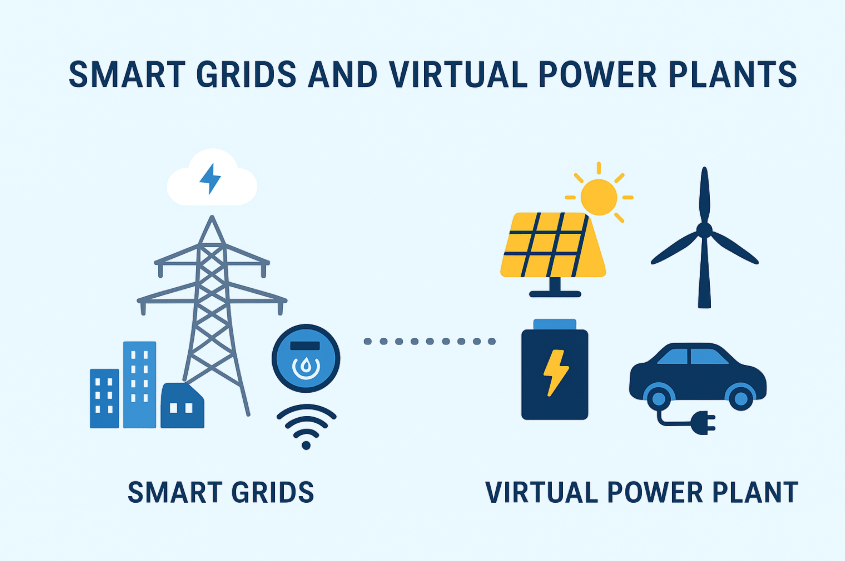
Real-World Case Studies
Case Study 1: Europe’s Smart Grid-VPP Integration
In Germany, one of the leaders in renewable adoption, smart grids are enabling VPP operators to aggregate thousands of residential solar and storage units. These resources are orchestrated in real-time to stabilize the grid and provide balancing services to transmission operators.
Case Study 2: United States – Smart Grids with Battery Storage
In California, utilities are deploying smart grids integrated with VPPs to reduce strain during peak summer demand. By combining smart meters, automated demand response, and residential battery systems, the state avoids rolling blackouts and reduces reliance on fossil fuel peaker plants.
Challenges and Future Outlook
1. Cybersecurity Risks
As more devices connect to the grid, the potential attack surface grows. Cybersecurity will be critical to protect smart grids and VPPs from malicious threats.
2. High Initial Investment
Building smart grids requires substantial capital for sensors, meters, communication infrastructure, and software platforms. However, the long-term savings often outweigh the upfront costs.
3. Regulatory Framework
Policymakers must adapt regulations to enable smart grid investments, incentivize demand response, and allow for energy trading within VPPs.
4. Data Privacy
With vast amounts of data being collected from consumers, utilities must ensure strong protections for privacy and data ownership.
Conclusion
Smart grids are more than just an upgrade to our existing power infrastructure. They are the foundation that enables Virtual Power Plants to function at scale, making renewable integration seamless, improving grid reliability, and empowering communities to take control of their energy.
As the world accelerates toward a clean energy future, the synergy between smart grids and VPPs will become increasingly indispensable. Together, they represent not just technological innovation, but also a pathway to resilience, sustainability, and shared prosperity.
👉 Next Reading: Community Energy Resilience Through Virtual Power Plants


